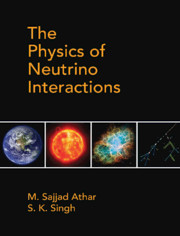Book contents
- Frontmatter
- Dedication
- Contents
- List of Figures
- List of Tables
- Preface
- Acknowledgments
- Chapter 1 Neutrino Properties and Its Interactions
- Chapter 2 Relativistic Particles and Neutrinos
- Chapter 3 Quantization of Free Particle Fields
- Chapter 4 Interacting Fields and Relativistic Perturbation Theory
- Chapter 5 Phenomenological Theory I: Nuclear β-decays and Weak Interaction of Leptons
- Chapter 6 Phenomenological Theory II: Weak Decays of Hadrons
- Chapter 7 Gauge Field Theories and Fundamental Interactions
- Chapter 8 Unified Theory of Electroweak Interactions
- Chapter 9 Neutrino and Electron Scattering from Point Particles
- Chapter 10 Neutrino scattering Cross Sections from Hadrons: Quasielastic Scattering
- Chapter 11 Neutrino Scattering from Hadrons: Inelastic Scattering (I)
- Chapter 12 Neutrino Scattering from Hadrons: Inelastic Scattering (II)
- Chapter 13 Neutrino Scattering from Hadrons: Deep Inelastic Scattering
- Chapter 14 Weak Quasielastic v(⊽)-nucleus Scattering
- Chapter 15 Inelastic Scattering of (Anti)neutrinos from Nuclei
- Chapter 16 Deep Inelastic Scattering of (Anti)neutrinos from Nuclei
- Chapter 17 Neutrino Sources and Detection of Neutrinos
- Chapter 18 Neutrino Mixing and Oscillations
- Chapter 19 Neutrino Astrophysics and the Synthesis of Elements
- Chapter 20 Neutrino Interactions Beyond the Standard Model
- Appendices
- Appendix A Lorentz Transformation and Covariance of the Dirac Equation
- Appendix B Cabibbo Theory
- Appendix C Some Properties of Pauli and Dirac Matrices and Spin Density Matrices
- Appendix D Leptonic and Hadronic Tensors
- Appendix E General Expression for the Total Scattering Cross Section and Decay Rates
- Appendix F Expressions of N(q2), the Coefficients of the Polarization Observables
- References
- Index
Chapter 2 - Relativistic Particles and Neutrinos
Published online by Cambridge University Press: 22 May 2020
- Frontmatter
- Dedication
- Contents
- List of Figures
- List of Tables
- Preface
- Acknowledgments
- Chapter 1 Neutrino Properties and Its Interactions
- Chapter 2 Relativistic Particles and Neutrinos
- Chapter 3 Quantization of Free Particle Fields
- Chapter 4 Interacting Fields and Relativistic Perturbation Theory
- Chapter 5 Phenomenological Theory I: Nuclear β-decays and Weak Interaction of Leptons
- Chapter 6 Phenomenological Theory II: Weak Decays of Hadrons
- Chapter 7 Gauge Field Theories and Fundamental Interactions
- Chapter 8 Unified Theory of Electroweak Interactions
- Chapter 9 Neutrino and Electron Scattering from Point Particles
- Chapter 10 Neutrino scattering Cross Sections from Hadrons: Quasielastic Scattering
- Chapter 11 Neutrino Scattering from Hadrons: Inelastic Scattering (I)
- Chapter 12 Neutrino Scattering from Hadrons: Inelastic Scattering (II)
- Chapter 13 Neutrino Scattering from Hadrons: Deep Inelastic Scattering
- Chapter 14 Weak Quasielastic v(⊽)-nucleus Scattering
- Chapter 15 Inelastic Scattering of (Anti)neutrinos from Nuclei
- Chapter 16 Deep Inelastic Scattering of (Anti)neutrinos from Nuclei
- Chapter 17 Neutrino Sources and Detection of Neutrinos
- Chapter 18 Neutrino Mixing and Oscillations
- Chapter 19 Neutrino Astrophysics and the Synthesis of Elements
- Chapter 20 Neutrino Interactions Beyond the Standard Model
- Appendices
- Appendix A Lorentz Transformation and Covariance of the Dirac Equation
- Appendix B Cabibbo Theory
- Appendix C Some Properties of Pauli and Dirac Matrices and Spin Density Matrices
- Appendix D Leptonic and Hadronic Tensors
- Appendix E General Expression for the Total Scattering Cross Section and Decay Rates
- Appendix F Expressions of N(q2), the Coefficients of the Polarization Observables
- References
- Index
Summary
Relativistic Notation
Neutrinos are neutral particles of spin; they are completely relativistic inthe massless limit. In order to describe neutrinos and their interactions,we need a relativistic theory of spin 1 particles. The appropriate frameworkto describe the elementary particles in general and the neutrinos inparticular, is relativistic quantum mechanics and quantum field theory. Inthis chapter and in the next two chapters, we present the essentials ofthese topics required to understand the physics of the weak interactions ofneutrinos and other particles of spin 0, 1, and.
We shall use natural units, in which ћ = c = 1, such that all thephysical quantities like mass, energy, momentum, length, time, force, etc.are expressed in terms of energy. In natural units:
The original physical quantities can be retrieved by multiplying thequantities expressed in energy units by appropriate powers of the factorsћ, c, and ћc. For example, mass m =E/c2, momentump = E/c, lengthl = ћc/E, andtime t = ћ /E,etc.
Metric tensor
In the relativistic framework, space and time are treated on equal footingand the equations of motion for particles are described in terms ofspace–time coordinates treated as four- component vectors, in afour-dimensional space called Minkowski space, defined byxμ, whereμ = 0, 1, 2, 3 andxμ =(x0' = t,x1 = x,x2 = y,x3 = z')in any inertial frame, say S. In another inertial frame,say, whichis moving with a velocity in the positive Xdirection, the space–time coordinates are related toxμ through
the Lorentz transformation given by:
such that
remains invariant under Lorentz transformations. For this reason, thequantity is called the length of the four-component vectorxμ in analogy with the length ofan ordinary vector, that is, which is invariant under rotation inthree-dimensional Euclidean space. Therefore, the Lorentz transformationsshown in Eq. (2.1) are equivalent to a rotation in a four-dimensionalMinkowski space in which the quantity defined as, remains invariant, thatis, it transforms as a scalar quantity under the Lorentz transformation.This is similar to a rotation in the three-dimensional Euclidean space inwhich the length of an ordinary vector, defined as remains invariant, thatis, transforms as a scalar under rotation.
- Type
- Chapter
- Information
- The Physics of Neutrino Interactions , pp. 42 - 95Publisher: Cambridge University PressPrint publication year: 2020



